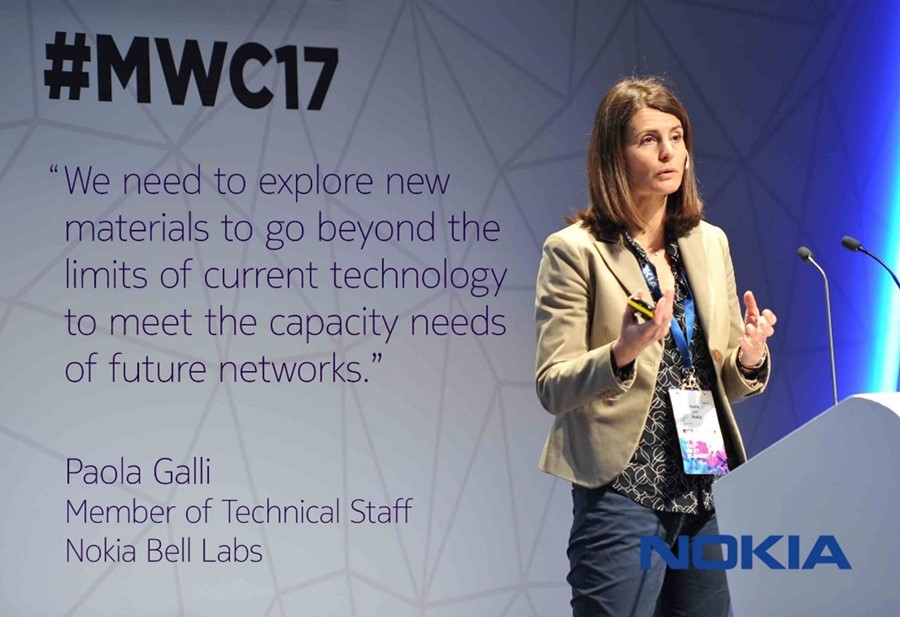Spotlight: Graphene for 5G communication and more with Nokia’s Paola Galli
Developing next-generation graphene-based optical networks for 5G and future communication technologies with Nokia’s Paola Galli
Paola Galli is an expert in photonic transceivers for next-generation optical networks. In 2020, she was appointed a Distinguished Member of Technical staff in Nokia’s IP and Optical Networks R&D group.
Galli introduced Nokia Italy to the Graphene Flagship consortium, and she leads the Graphene Flagship Spearhead Project METROGRAPH, which aims to devise a low-cost optical transceiver to transmit and receive data with graphene-enabled photonics.
Read about her background, career and goals as a researcher in this exclusive interview.
How did you first become interested in your current research project?
I mostly focus on designing, characterising and finding new applications of graphene devices in telecommunications. I want to address the limitations of current technologies and support faster, larger broadbands and more reliable optical networks.
Why graphene?
Graphene can be a real game-changer in photonics for telecommunications. It expands the potential of silicon photonics with new functionalities, and allows for high-speed light modulation and detection with low energy consumption and affordable costs.
How can our society benefit from this?
Telecom networks are a pillar of today’s society. In the wake of the COVID-19 pandemic, demand for broadband services has skyrocketed, as families, businesses and customers have tried to stay connected.
Graphene photonics can enable low power consumption photonic devices, which may help to reduce CO2 emissions related to energy production. Graphene is a promising materials that could help bring us close to Nokia’s ambitious target of a tenfold reduction in the telecom industry’s energy footprint.
Which are METROGRAPH’s strengths?
I believe METROGRAPH’s biggest strength is the broad range of fields it encompasses, which span from materials science to industrial applications. I am very privileged to be able to conduct my research in collaboration with a team of best-in-class researchers and top European academic partners, enabled by METROGRAPH.
What are the biggest milestones in your career – or your proudest moments?
My first milestone was at the beginning of my career when I was selected to join a two-person team in a start-up. That little company later grew to 16 members and was acquired by Agilent for 55 million dollars. I was extremely proud of our success.
During my time at Pirelli Labs, I led a team that designed photonic modules and filed the highest number of patents in my career. Then, after working for Alcatel-Lucent’s Bell Labs, I joined the Nokia IP and Optical Networks business group, and was appointed a Distinguished Member of Technical Staff.
In 2020 I also received the Ada Lovelace honoree: a recognition given by Nokia to women who, like the mathematician Ada Lovelace, follow their passion for science and technology.
What are you and your company doing to further the diversity in STEM cause?
Nokia has several programs to nurture diversity awareness and support gender balance and equality in the company.
I fully support diverse and inclusive scientific or industrial environments that attract the best talent. I think diversity is great value for a research team, and it is essential for innovation and success. We have the chance – and the duty – to shape our approach to diversity for current and future generations. For example, we all have to work actively to increase the number of women in science and technology. It is a long journey to overcome cultural limitations, but the road is paved and the results are already starting to be visible.
Who is your role model?
During my youth, my role models were primarily sports champions in sailing, skiing and Formula 1 racing. I surmised that fair competition, hard work, a stong vision and creativity can lead to rewarding results. The very same values were fundamental for my professional career.
Furthermore, when I was still a teenager, my father told me the story of Marisa Bellisario, the CEO of Italtel in the late 1980s, who fought for gender parity throughout her life. I believe I have been lucky to find inspiring mentors in each of my positions, and thanks to them, I have learned so much. They taught me how to think creatively, focus on relevant things, and pursue objectives. My parents also inspired me as examples of competency, dedication and honesty.
What are your plans for the future?
I would like to continue to delve into new applications of telecom technologies and further explore the potential of graphene. I wish to contribute to bringing this technology to a maturity level that allows for its adoption in next-generation telecommunication networks.

Paola Galli presented her research project with the Graphene Flagship at Mobile World Congress 2017 in Barcelona. (Credit: Nokia)




